Unionization: Pros and Cons of Labour Union in Collective Bargaining
VerifiedAdded on 2023/04/20
|15
|1877
|391
AI Summary
This report discusses the pros and cons of unionization and its role in collective bargaining. It explores the benefits of increased pay and benefits for employees, simplified dispute resolution procedures, and political organizing. It also examines the potential drawbacks, such as the impact on good workers and the financial burden on some employees. Overall, unionization can have a positive impact on employee rights and working conditions, but it also has its challenges.
Contribute Materials
Your contribution can guide someone’s learning journey. Share your
documents today.

2/9/2019
UNIONIZATION 0
HRM Labor Relations
Student’s Name
UNIONIZATION 0
HRM Labor Relations
Student’s Name
Secure Best Marks with AI Grader
Need help grading? Try our AI Grader for instant feedback on your assignments.
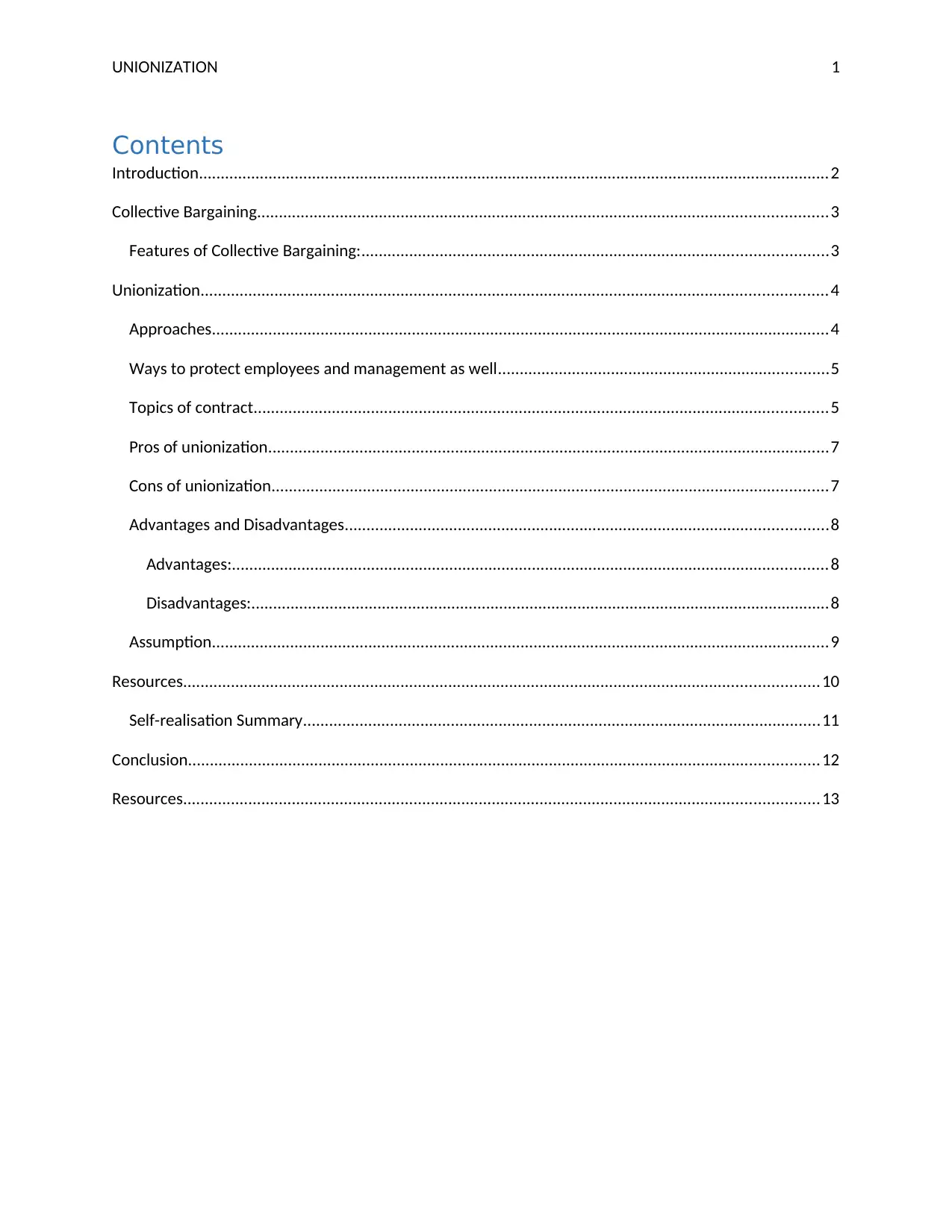
UNIONIZATION 1
Contents
Introduction.................................................................................................................................................2
Collective Bargaining...................................................................................................................................3
Features of Collective Bargaining:...........................................................................................................3
Unionization................................................................................................................................................4
Approaches..............................................................................................................................................4
Ways to protect employees and management as well............................................................................5
Topics of contract....................................................................................................................................5
Pros of unionization.................................................................................................................................7
Cons of unionization................................................................................................................................7
Advantages and Disadvantages...............................................................................................................8
Advantages:.........................................................................................................................................8
Disadvantages:.....................................................................................................................................8
Assumption..............................................................................................................................................9
Resources..................................................................................................................................................10
Self-realisation Summary.......................................................................................................................11
Conclusion.................................................................................................................................................12
Resources..................................................................................................................................................13
Contents
Introduction.................................................................................................................................................2
Collective Bargaining...................................................................................................................................3
Features of Collective Bargaining:...........................................................................................................3
Unionization................................................................................................................................................4
Approaches..............................................................................................................................................4
Ways to protect employees and management as well............................................................................5
Topics of contract....................................................................................................................................5
Pros of unionization.................................................................................................................................7
Cons of unionization................................................................................................................................7
Advantages and Disadvantages...............................................................................................................8
Advantages:.........................................................................................................................................8
Disadvantages:.....................................................................................................................................8
Assumption..............................................................................................................................................9
Resources..................................................................................................................................................10
Self-realisation Summary.......................................................................................................................11
Conclusion.................................................................................................................................................12
Resources..................................................................................................................................................13
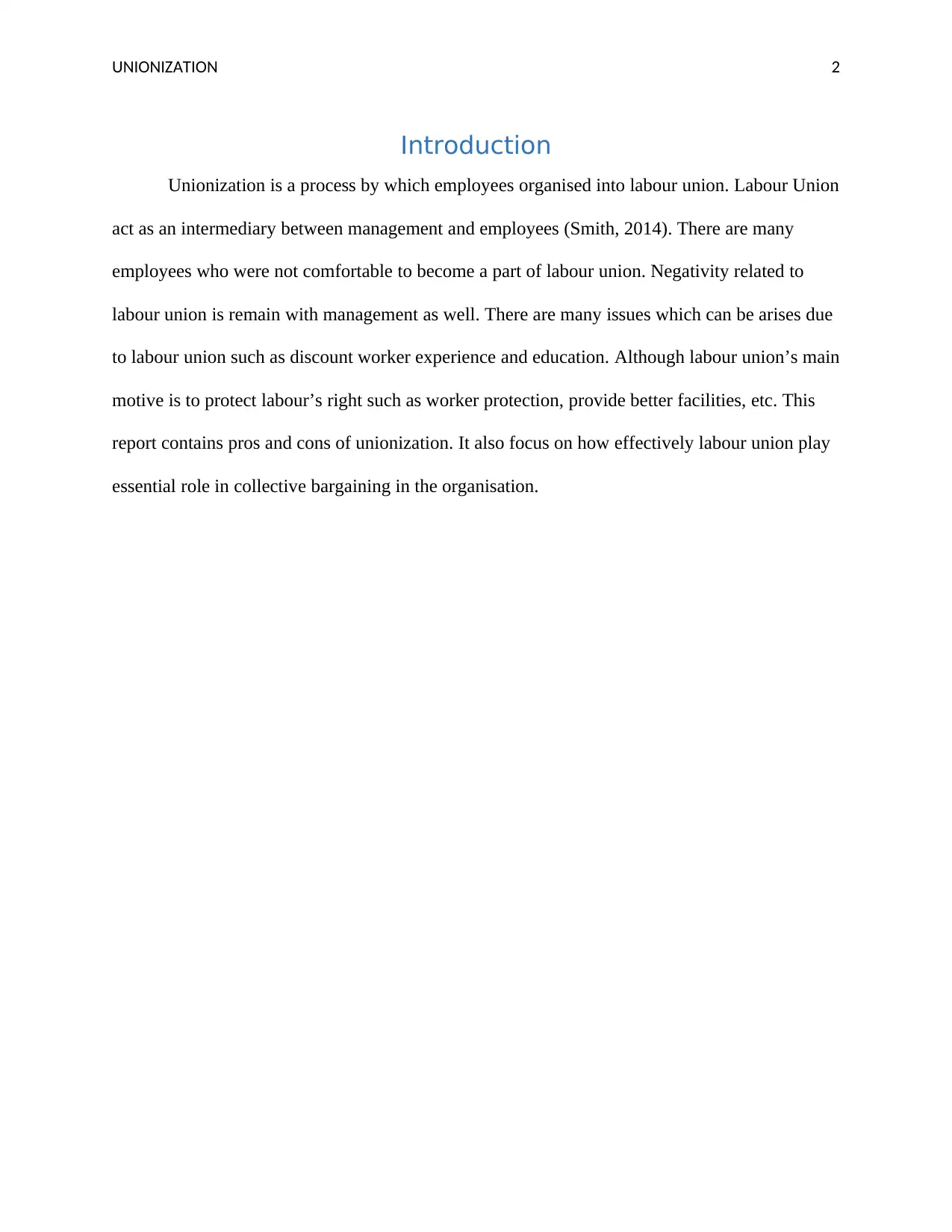
UNIONIZATION 2
Introduction
Unionization is a process by which employees organised into labour union. Labour Union
act as an intermediary between management and employees (Smith, 2014). There are many
employees who were not comfortable to become a part of labour union. Negativity related to
labour union is remain with management as well. There are many issues which can be arises due
to labour union such as discount worker experience and education. Although labour union’s main
motive is to protect labour’s right such as worker protection, provide better facilities, etc. This
report contains pros and cons of unionization. It also focus on how effectively labour union play
essential role in collective bargaining in the organisation.
Introduction
Unionization is a process by which employees organised into labour union. Labour Union
act as an intermediary between management and employees (Smith, 2014). There are many
employees who were not comfortable to become a part of labour union. Negativity related to
labour union is remain with management as well. There are many issues which can be arises due
to labour union such as discount worker experience and education. Although labour union’s main
motive is to protect labour’s right such as worker protection, provide better facilities, etc. This
report contains pros and cons of unionization. It also focus on how effectively labour union play
essential role in collective bargaining in the organisation.
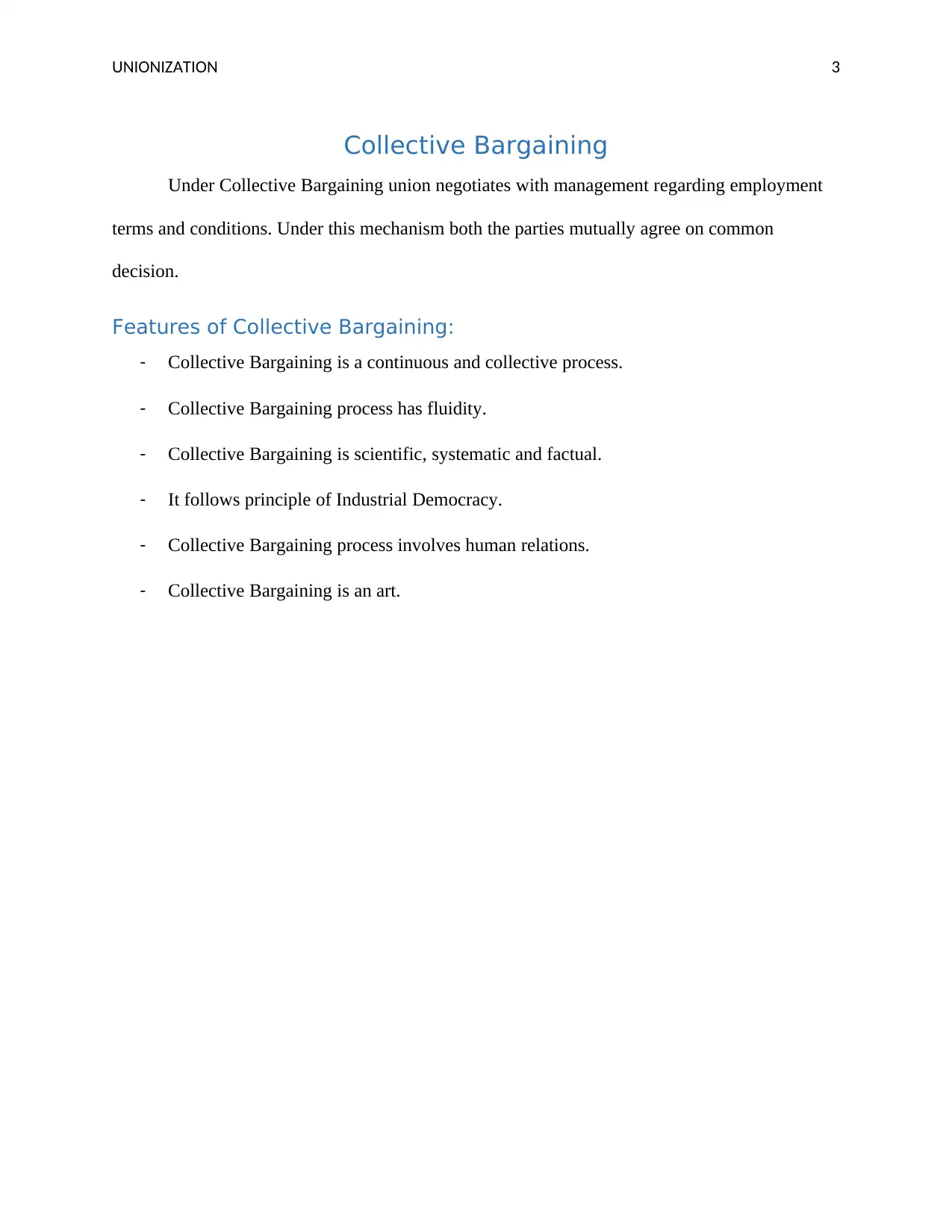
UNIONIZATION 3
Collective Bargaining
Under Collective Bargaining union negotiates with management regarding employment
terms and conditions. Under this mechanism both the parties mutually agree on common
decision.
Features of Collective Bargaining:
- Collective Bargaining is a continuous and collective process.
- Collective Bargaining process has fluidity.
- Collective Bargaining is scientific, systematic and factual.
- It follows principle of Industrial Democracy.
- Collective Bargaining process involves human relations.
- Collective Bargaining is an art.
Collective Bargaining
Under Collective Bargaining union negotiates with management regarding employment
terms and conditions. Under this mechanism both the parties mutually agree on common
decision.
Features of Collective Bargaining:
- Collective Bargaining is a continuous and collective process.
- Collective Bargaining process has fluidity.
- Collective Bargaining is scientific, systematic and factual.
- It follows principle of Industrial Democracy.
- Collective Bargaining process involves human relations.
- Collective Bargaining is an art.
Secure Best Marks with AI Grader
Need help grading? Try our AI Grader for instant feedback on your assignments.

UNIONIZATION 4
Unionization
Approaches
Labour union is a way for employees to communicate with the management regarding their
employment terms and conditions. This is two sided activity where both members of union and
senior authority negotiate with each other after considering each other proposals. Meeting
between them requires concentration, patience and lots of understanding regarding proposals
made. But sometimes proposals were unethical or situation goes out of control which create rift
between management and union. Approaches to improve working conditions with labour union:
- Mutual Respect.
- Communication.
- Pre-emptive Policies.
- Maintaining Discipline.
- Cope up with management deadlines.
- Avoid abusive behaviour.
- Effective Collective Bargaining.
- Redressing grievances.
- Avoid payment dues.
- Maintaining good relations.
Unionization
Approaches
Labour union is a way for employees to communicate with the management regarding their
employment terms and conditions. This is two sided activity where both members of union and
senior authority negotiate with each other after considering each other proposals. Meeting
between them requires concentration, patience and lots of understanding regarding proposals
made. But sometimes proposals were unethical or situation goes out of control which create rift
between management and union. Approaches to improve working conditions with labour union:
- Mutual Respect.
- Communication.
- Pre-emptive Policies.
- Maintaining Discipline.
- Cope up with management deadlines.
- Avoid abusive behaviour.
- Effective Collective Bargaining.
- Redressing grievances.
- Avoid payment dues.
- Maintaining good relations.
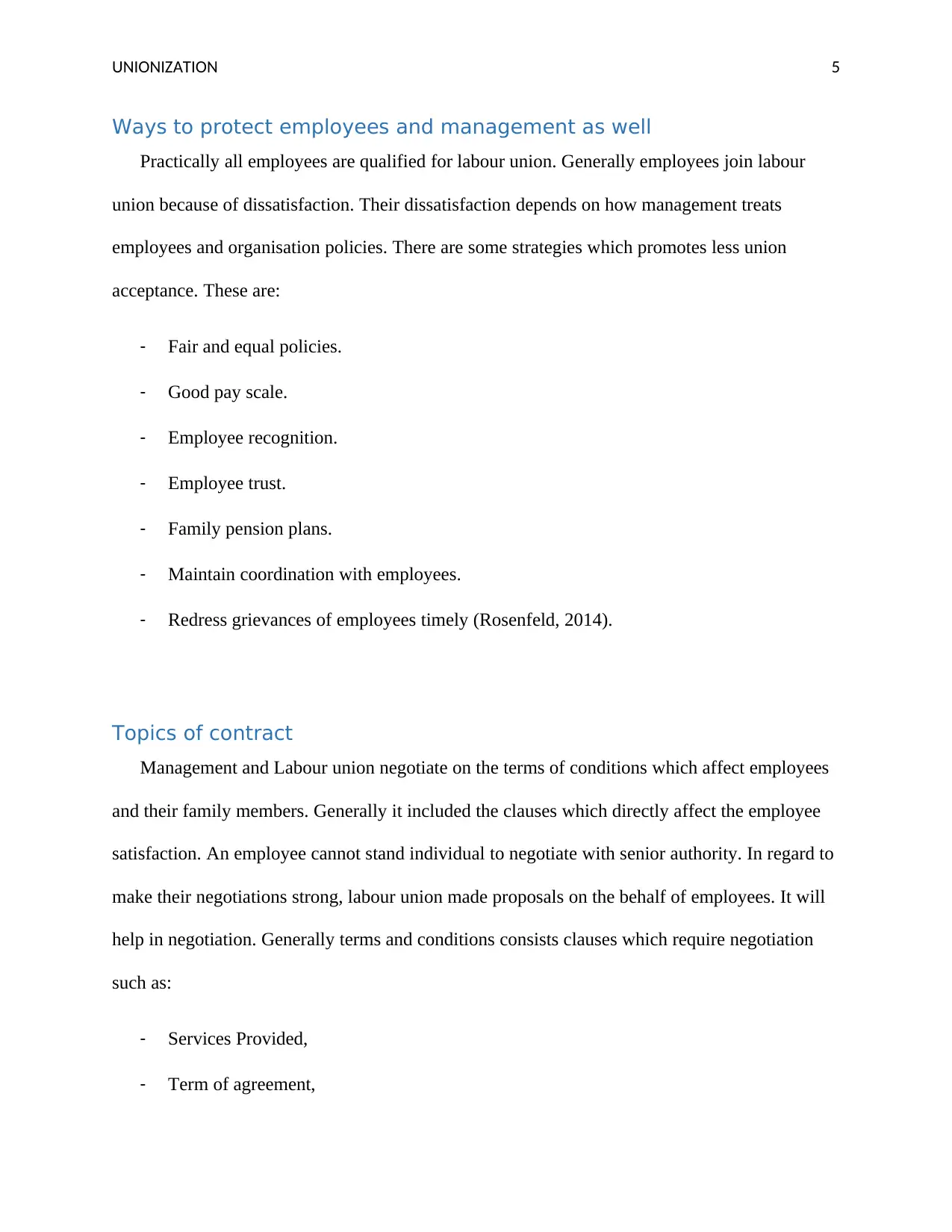
UNIONIZATION 5
Ways to protect employees and management as well
Practically all employees are qualified for labour union. Generally employees join labour
union because of dissatisfaction. Their dissatisfaction depends on how management treats
employees and organisation policies. There are some strategies which promotes less union
acceptance. These are:
- Fair and equal policies.
- Good pay scale.
- Employee recognition.
- Employee trust.
- Family pension plans.
- Maintain coordination with employees.
- Redress grievances of employees timely (Rosenfeld, 2014).
Topics of contract
Management and Labour union negotiate on the terms of conditions which affect employees
and their family members. Generally it included the clauses which directly affect the employee
satisfaction. An employee cannot stand individual to negotiate with senior authority. In regard to
make their negotiations strong, labour union made proposals on the behalf of employees. It will
help in negotiation. Generally terms and conditions consists clauses which require negotiation
such as:
- Services Provided,
- Term of agreement,
Ways to protect employees and management as well
Practically all employees are qualified for labour union. Generally employees join labour
union because of dissatisfaction. Their dissatisfaction depends on how management treats
employees and organisation policies. There are some strategies which promotes less union
acceptance. These are:
- Fair and equal policies.
- Good pay scale.
- Employee recognition.
- Employee trust.
- Family pension plans.
- Maintain coordination with employees.
- Redress grievances of employees timely (Rosenfeld, 2014).
Topics of contract
Management and Labour union negotiate on the terms of conditions which affect employees
and their family members. Generally it included the clauses which directly affect the employee
satisfaction. An employee cannot stand individual to negotiate with senior authority. In regard to
make their negotiations strong, labour union made proposals on the behalf of employees. It will
help in negotiation. Generally terms and conditions consists clauses which require negotiation
such as:
- Services Provided,
- Term of agreement,
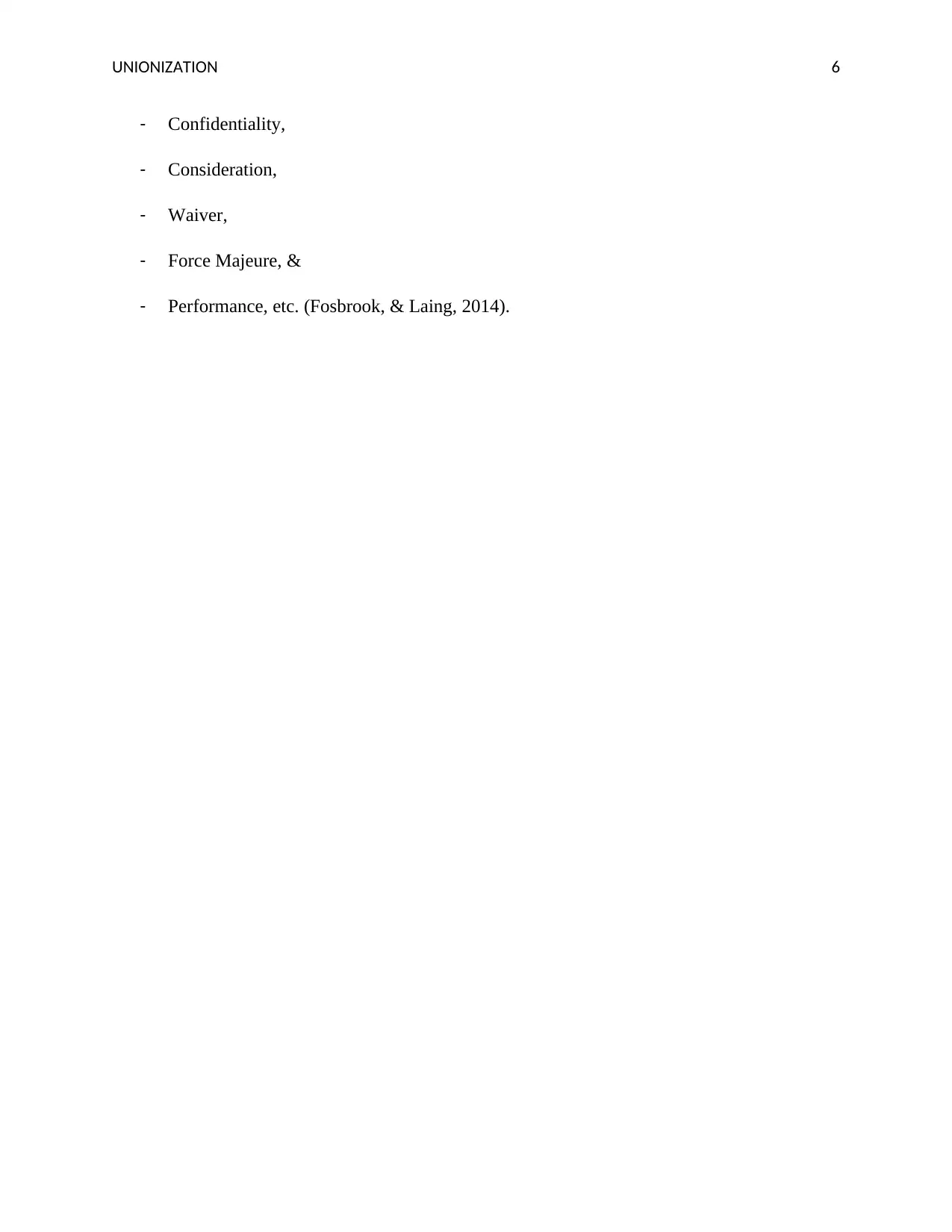
UNIONIZATION 6
- Confidentiality,
- Consideration,
- Waiver,
- Force Majeure, &
- Performance, etc. (Fosbrook, & Laing, 2014).
- Confidentiality,
- Consideration,
- Waiver,
- Force Majeure, &
- Performance, etc. (Fosbrook, & Laing, 2014).
Paraphrase This Document
Need a fresh take? Get an instant paraphrase of this document with our AI Paraphraser

UNIONIZATION 7
Pros of unionization
- Increment in pay and benefits of employees: Labour union’s main motive is to increase
Doctors pay and provide benefits to employees and their families as well.
- Simple procedure for disputes and complaints: Labour union make rules and regulations
regarding procedure for disputes and complaints. They make simple guidelines.
- Make political organizing easy: Generally labour union’s member is involved in political
contribution which help union to make their argument strong.
- Reduced unethical actions: Labour union handles matter related to employee welfare
which reduced unethical activity by employees (Preuss, Gold & Rees, 2014).
Cons of unionization
- Fails to promote good workers: Labour union influence so well but it is not good for good
doctors to boost up their hierarchy.
- Some workers might not want to pay fees to union: Labour union charge some fee for the
development and maintenance of trade union. Some workers unable to pay as their
financial conditions were not good or might be some workers do not want to pay.
- Hospital may become less competitive: Labour union demands higher wages sometime
which may result in less profitable unless doctors become more sensible, responsible and
productive.
- Employee inventiveness is muffled: Promotion in union is depends on base raises and
seniority. This culture disappoint workers of union. It discourages employee
inventiveness and individualism (Addison, 2009).
Pros of unionization
- Increment in pay and benefits of employees: Labour union’s main motive is to increase
Doctors pay and provide benefits to employees and their families as well.
- Simple procedure for disputes and complaints: Labour union make rules and regulations
regarding procedure for disputes and complaints. They make simple guidelines.
- Make political organizing easy: Generally labour union’s member is involved in political
contribution which help union to make their argument strong.
- Reduced unethical actions: Labour union handles matter related to employee welfare
which reduced unethical activity by employees (Preuss, Gold & Rees, 2014).
Cons of unionization
- Fails to promote good workers: Labour union influence so well but it is not good for good
doctors to boost up their hierarchy.
- Some workers might not want to pay fees to union: Labour union charge some fee for the
development and maintenance of trade union. Some workers unable to pay as their
financial conditions were not good or might be some workers do not want to pay.
- Hospital may become less competitive: Labour union demands higher wages sometime
which may result in less profitable unless doctors become more sensible, responsible and
productive.
- Employee inventiveness is muffled: Promotion in union is depends on base raises and
seniority. This culture disappoint workers of union. It discourages employee
inventiveness and individualism (Addison, 2009).
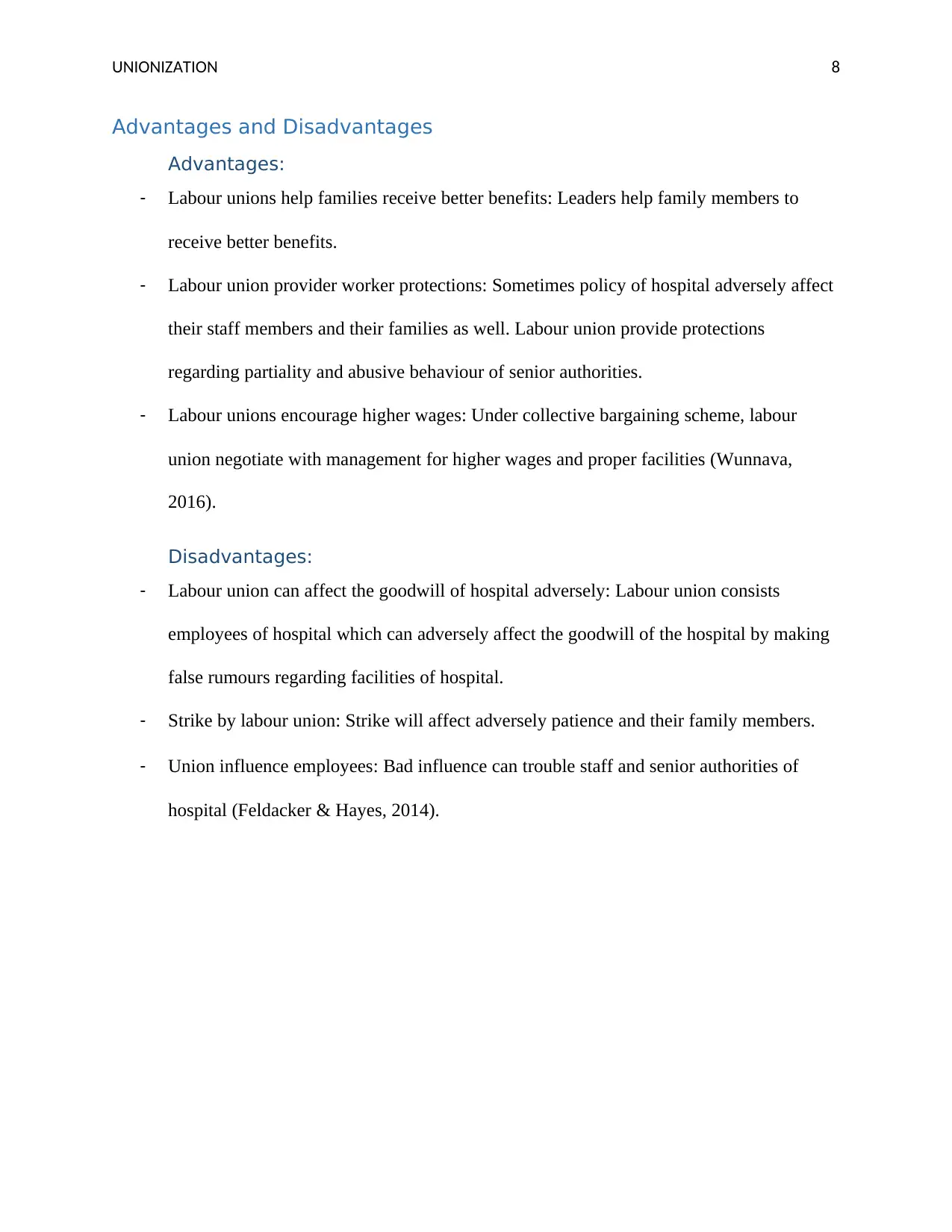
UNIONIZATION 8
Advantages and Disadvantages
Advantages:
- Labour unions help families receive better benefits: Leaders help family members to
receive better benefits.
- Labour union provider worker protections: Sometimes policy of hospital adversely affect
their staff members and their families as well. Labour union provide protections
regarding partiality and abusive behaviour of senior authorities.
- Labour unions encourage higher wages: Under collective bargaining scheme, labour
union negotiate with management for higher wages and proper facilities (Wunnava,
2016).
Disadvantages:
- Labour union can affect the goodwill of hospital adversely: Labour union consists
employees of hospital which can adversely affect the goodwill of the hospital by making
false rumours regarding facilities of hospital.
- Strike by labour union: Strike will affect adversely patience and their family members.
- Union influence employees: Bad influence can trouble staff and senior authorities of
hospital (Feldacker & Hayes, 2014).
Advantages and Disadvantages
Advantages:
- Labour unions help families receive better benefits: Leaders help family members to
receive better benefits.
- Labour union provider worker protections: Sometimes policy of hospital adversely affect
their staff members and their families as well. Labour union provide protections
regarding partiality and abusive behaviour of senior authorities.
- Labour unions encourage higher wages: Under collective bargaining scheme, labour
union negotiate with management for higher wages and proper facilities (Wunnava,
2016).
Disadvantages:
- Labour union can affect the goodwill of hospital adversely: Labour union consists
employees of hospital which can adversely affect the goodwill of the hospital by making
false rumours regarding facilities of hospital.
- Strike by labour union: Strike will affect adversely patience and their family members.
- Union influence employees: Bad influence can trouble staff and senior authorities of
hospital (Feldacker & Hayes, 2014).
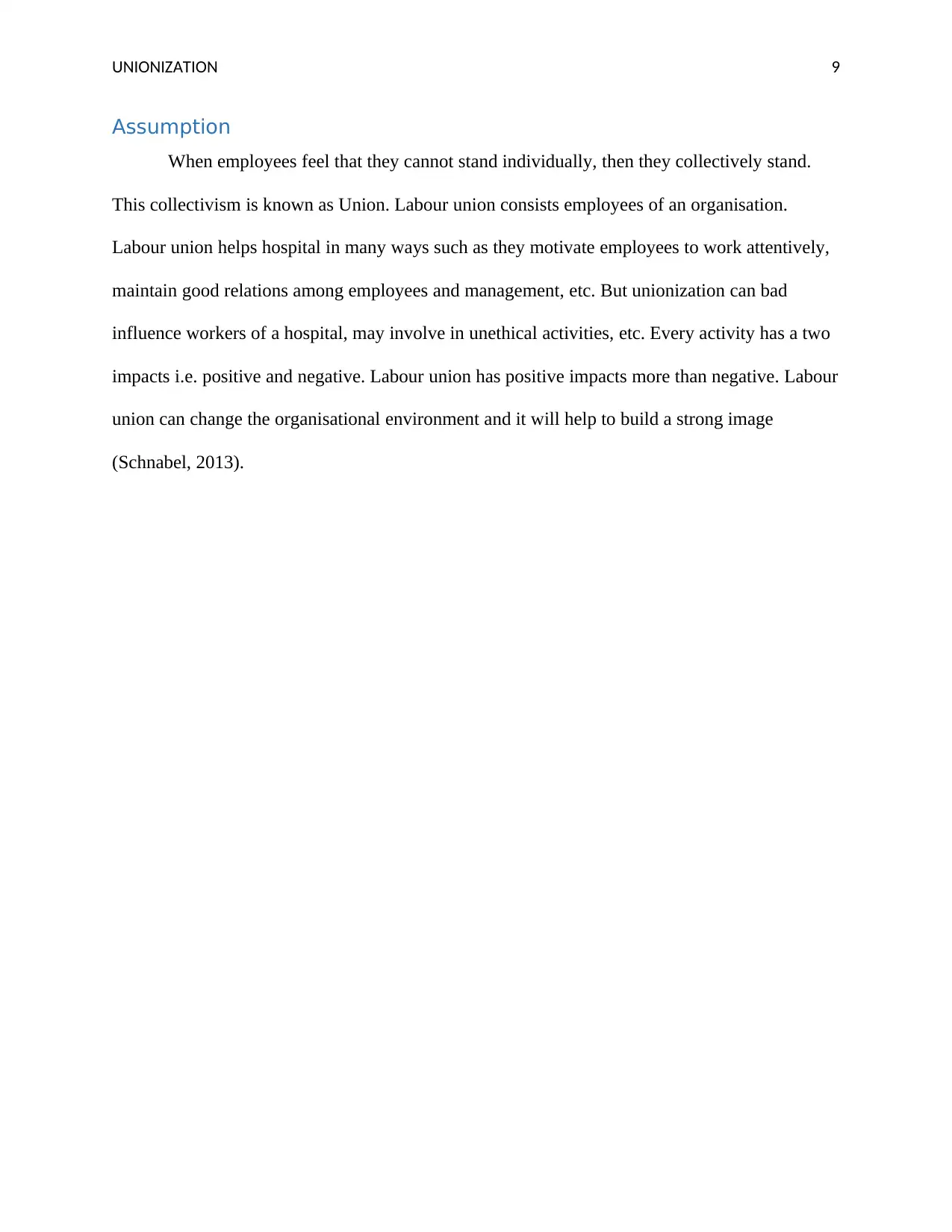
UNIONIZATION 9
Assumption
When employees feel that they cannot stand individually, then they collectively stand.
This collectivism is known as Union. Labour union consists employees of an organisation.
Labour union helps hospital in many ways such as they motivate employees to work attentively,
maintain good relations among employees and management, etc. But unionization can bad
influence workers of a hospital, may involve in unethical activities, etc. Every activity has a two
impacts i.e. positive and negative. Labour union has positive impacts more than negative. Labour
union can change the organisational environment and it will help to build a strong image
(Schnabel, 2013).
Assumption
When employees feel that they cannot stand individually, then they collectively stand.
This collectivism is known as Union. Labour union consists employees of an organisation.
Labour union helps hospital in many ways such as they motivate employees to work attentively,
maintain good relations among employees and management, etc. But unionization can bad
influence workers of a hospital, may involve in unethical activities, etc. Every activity has a two
impacts i.e. positive and negative. Labour union has positive impacts more than negative. Labour
union can change the organisational environment and it will help to build a strong image
(Schnabel, 2013).
Secure Best Marks with AI Grader
Need help grading? Try our AI Grader for instant feedback on your assignments.

UNIONIZATION 10
Resources
Labour union have significant influence on organisation. They provide proper wage plan,
other monetary benefits, a healthy work environment, Facilities for women workers and Health
and safety measures, etc. Union can help company and employees together with the help of
making smart policies. Labour union requires cooperation from management and employees as
well. They also needs support from the employees who were not member of union. As a Chief
Labour Negotiator, Labour union and chief Labour Council can help officer while negotiating.
They help to negotiate with the management about their presentations. Labour union is an
internal source of communicating and authority is an external source who can build a pressure on
management of organisation. They can affect the position of Chief Labour Negotiator because
they both can influence the management so well. Thus, they might affected the success of Chief
Labour Negotiator (Bielski Boris, 2011).
Resources
Labour union have significant influence on organisation. They provide proper wage plan,
other monetary benefits, a healthy work environment, Facilities for women workers and Health
and safety measures, etc. Union can help company and employees together with the help of
making smart policies. Labour union requires cooperation from management and employees as
well. They also needs support from the employees who were not member of union. As a Chief
Labour Negotiator, Labour union and chief Labour Council can help officer while negotiating.
They help to negotiate with the management about their presentations. Labour union is an
internal source of communicating and authority is an external source who can build a pressure on
management of organisation. They can affect the position of Chief Labour Negotiator because
they both can influence the management so well. Thus, they might affected the success of Chief
Labour Negotiator (Bielski Boris, 2011).
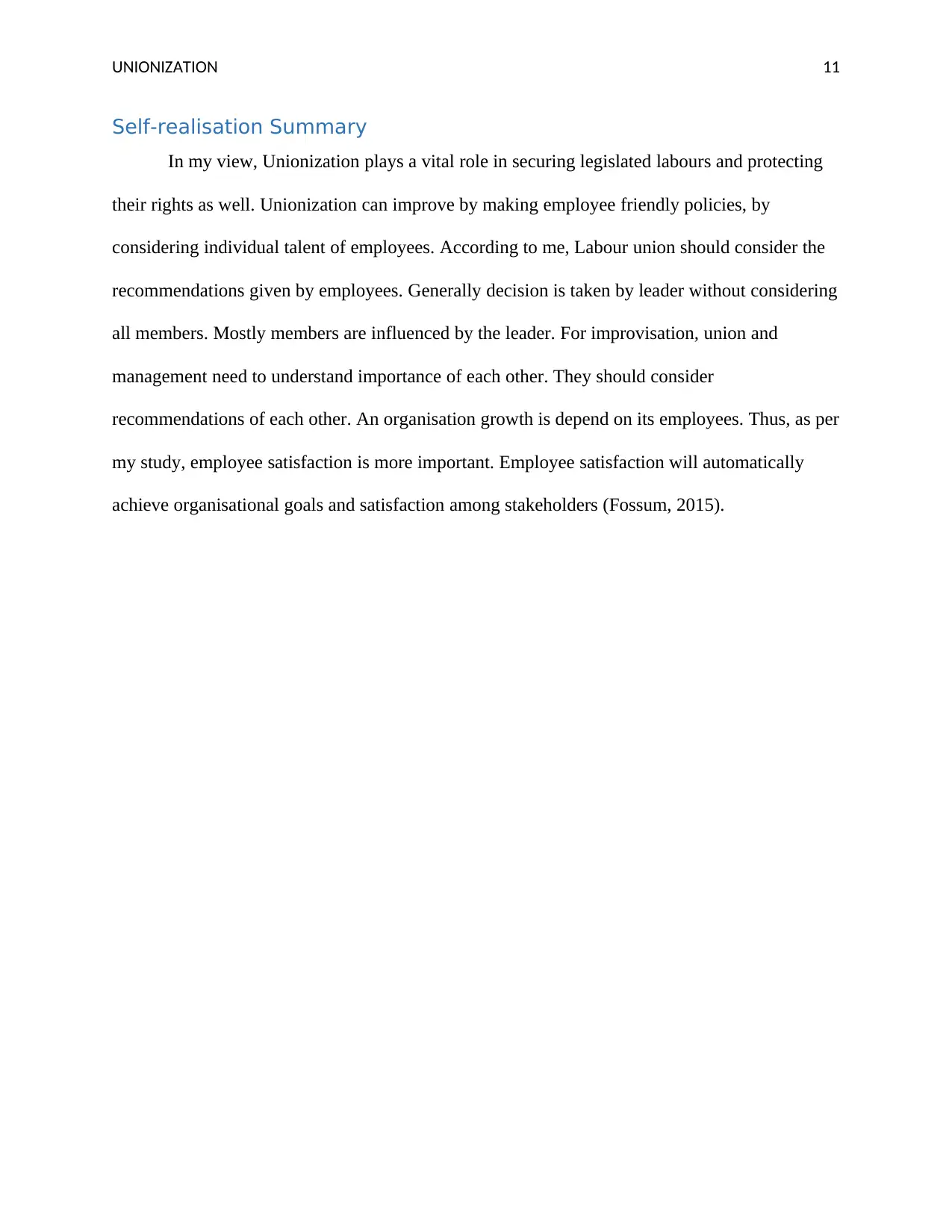
UNIONIZATION 11
Self-realisation Summary
In my view, Unionization plays a vital role in securing legislated labours and protecting
their rights as well. Unionization can improve by making employee friendly policies, by
considering individual talent of employees. According to me, Labour union should consider the
recommendations given by employees. Generally decision is taken by leader without considering
all members. Mostly members are influenced by the leader. For improvisation, union and
management need to understand importance of each other. They should consider
recommendations of each other. An organisation growth is depend on its employees. Thus, as per
my study, employee satisfaction is more important. Employee satisfaction will automatically
achieve organisational goals and satisfaction among stakeholders (Fossum, 2015).
Self-realisation Summary
In my view, Unionization plays a vital role in securing legislated labours and protecting
their rights as well. Unionization can improve by making employee friendly policies, by
considering individual talent of employees. According to me, Labour union should consider the
recommendations given by employees. Generally decision is taken by leader without considering
all members. Mostly members are influenced by the leader. For improvisation, union and
management need to understand importance of each other. They should consider
recommendations of each other. An organisation growth is depend on its employees. Thus, as per
my study, employee satisfaction is more important. Employee satisfaction will automatically
achieve organisational goals and satisfaction among stakeholders (Fossum, 2015).
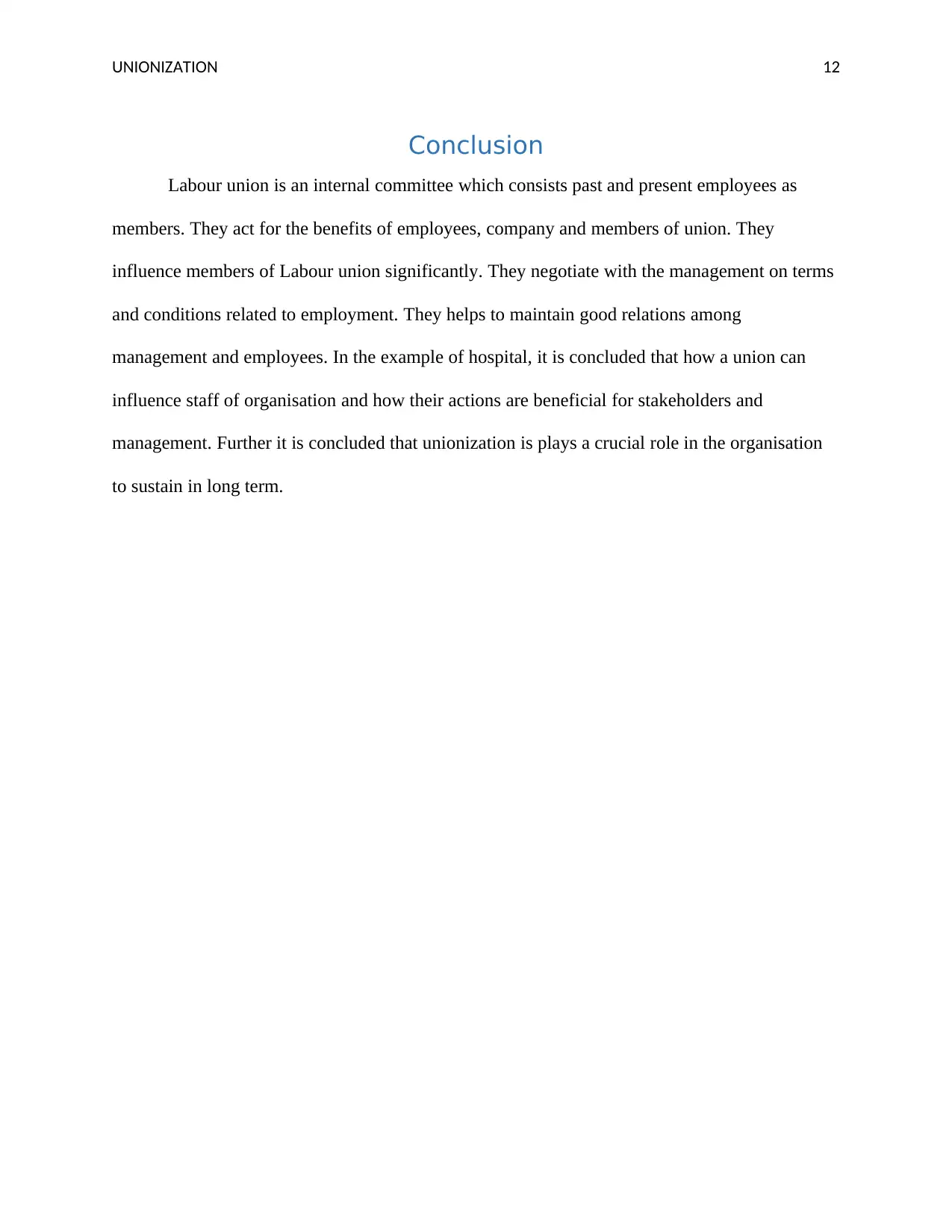
UNIONIZATION 12
Conclusion
Labour union is an internal committee which consists past and present employees as
members. They act for the benefits of employees, company and members of union. They
influence members of Labour union significantly. They negotiate with the management on terms
and conditions related to employment. They helps to maintain good relations among
management and employees. In the example of hospital, it is concluded that how a union can
influence staff of organisation and how their actions are beneficial for stakeholders and
management. Further it is concluded that unionization is plays a crucial role in the organisation
to sustain in long term.
Conclusion
Labour union is an internal committee which consists past and present employees as
members. They act for the benefits of employees, company and members of union. They
influence members of Labour union significantly. They negotiate with the management on terms
and conditions related to employment. They helps to maintain good relations among
management and employees. In the example of hospital, it is concluded that how a union can
influence staff of organisation and how their actions are beneficial for stakeholders and
management. Further it is concluded that unionization is plays a crucial role in the organisation
to sustain in long term.
Paraphrase This Document
Need a fresh take? Get an instant paraphrase of this document with our AI Paraphraser
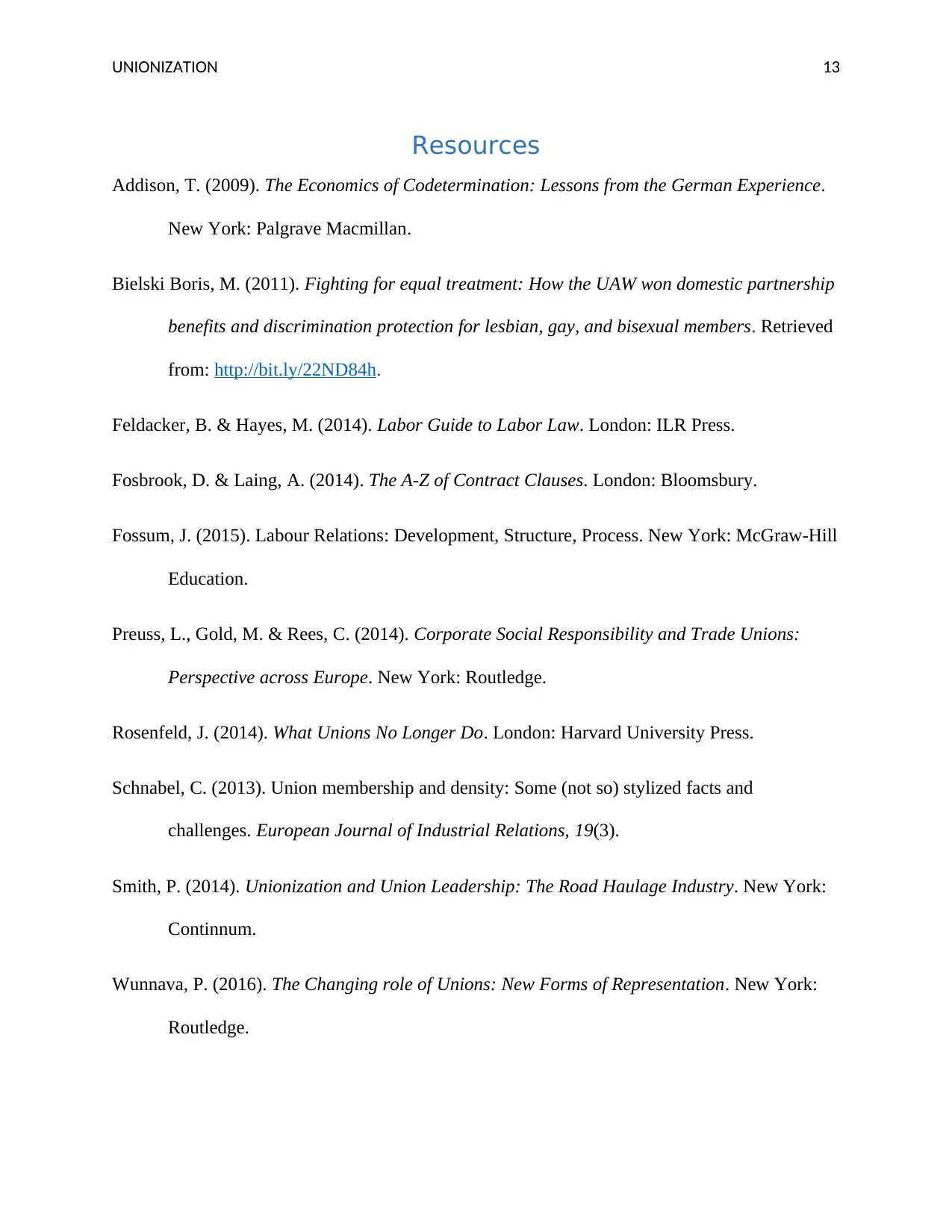
UNIONIZATION 13
Resources
Addison, T. (2009). The Economics of Codetermination: Lessons from the German Experience.
New York: Palgrave Macmillan.
Bielski Boris, M. (2011). Fighting for equal treatment: How the UAW won domestic partnership
benefits and discrimination protection for lesbian, gay, and bisexual members. Retrieved
from: http://bit.ly/22ND84h.
Feldacker, B. & Hayes, M. (2014). Labor Guide to Labor Law. London: ILR Press.
Fosbrook, D. & Laing, A. (2014). The A-Z of Contract Clauses. London: Bloomsbury.
Fossum, J. (2015). Labour Relations: Development, Structure, Process. New York: McGraw-Hill
Education.
Preuss, L., Gold, M. & Rees, C. (2014). Corporate Social Responsibility and Trade Unions:
Perspective across Europe. New York: Routledge.
Rosenfeld, J. (2014). What Unions No Longer Do. London: Harvard University Press.
Schnabel, C. (2013). Union membership and density: Some (not so) stylized facts and
challenges. European Journal of Industrial Relations, 19(3).
Smith, P. (2014). Unionization and Union Leadership: The Road Haulage Industry. New York:
Continnum.
Wunnava, P. (2016). The Changing role of Unions: New Forms of Representation. New York:
Routledge.
Resources
Addison, T. (2009). The Economics of Codetermination: Lessons from the German Experience.
New York: Palgrave Macmillan.
Bielski Boris, M. (2011). Fighting for equal treatment: How the UAW won domestic partnership
benefits and discrimination protection for lesbian, gay, and bisexual members. Retrieved
from: http://bit.ly/22ND84h.
Feldacker, B. & Hayes, M. (2014). Labor Guide to Labor Law. London: ILR Press.
Fosbrook, D. & Laing, A. (2014). The A-Z of Contract Clauses. London: Bloomsbury.
Fossum, J. (2015). Labour Relations: Development, Structure, Process. New York: McGraw-Hill
Education.
Preuss, L., Gold, M. & Rees, C. (2014). Corporate Social Responsibility and Trade Unions:
Perspective across Europe. New York: Routledge.
Rosenfeld, J. (2014). What Unions No Longer Do. London: Harvard University Press.
Schnabel, C. (2013). Union membership and density: Some (not so) stylized facts and
challenges. European Journal of Industrial Relations, 19(3).
Smith, P. (2014). Unionization and Union Leadership: The Road Haulage Industry. New York:
Continnum.
Wunnava, P. (2016). The Changing role of Unions: New Forms of Representation. New York:
Routledge.

UNIONIZATION 14
1 out of 15
Related Documents
Your All-in-One AI-Powered Toolkit for Academic Success.
+13062052269
info@desklib.com
Available 24*7 on WhatsApp / Email
![[object Object]](/_next/static/media/star-bottom.7253800d.svg)
Unlock your academic potential
© 2024 | Zucol Services PVT LTD | All rights reserved.





